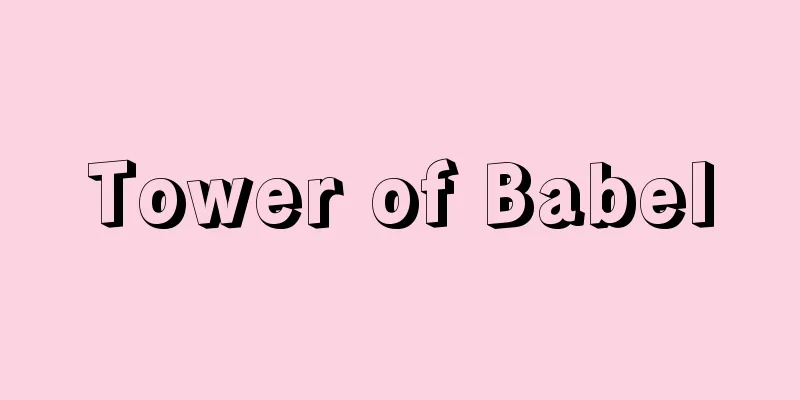Tower of Babel

|
A tall brick tower described in the Book of Genesis in the Old Testament. According to the story, after Noah's great flood, humans built a city and a tower out of bricks in Shinar (Babylonia), with the aim of reaching the top of the tower to the heavens. When God saw this, he confused the language of humans, which had been one until then, so that humans could no longer communicate with each other. There is a cultural historical fact behind this story. In ancient Mesopotamia, each large city built a magnificent tower called a ziggurat out of sun-dried bricks, and held various religious ceremonies there. This fact has been proven by archaeological excavations. When the ancient Israelites, who were politically, economically, and culturally inferior, saw and heard about this tower, they were not envious of it, but rather tried to see through the self-confidence and arrogance of humans hidden behind such a civilization. They also realized that political power that intimidates people with such large buildings would ultimately divide them rather than unite them. The story of the Tower of Babel was born from this criticism of civilization. The "Tower of Babel" is used metaphorically to mean the work of human pride. The Tower of Babel, which is often seen in early modern Western paintings, also often contains a similar criticism of civilization. Babel is a play on words between Babylon and Baral (to disturb). [Tsukimoto Akio] "Words and the Bible" by Maeda Mamoro (1963, Iwanami Shoten) Source: Shogakukan Encyclopedia Nipponica About Encyclopedia Nipponica Information | Legend |
|
『旧約聖書』「創世記」に記されたれんが造りの高い塔。物語によれば、人類はノアの大洪水ののち、シナル(バビロニア)の地にれんがをもって町と塔を建て、その頂を天にまで届かせようとした。神はこれをみて、それまで一つであった人類の言語を乱し、人間が互いに意志疎通できないようにしたという。この物語の背景には文化史的な事実がある。というのは、古代メソポタミアにおいて、各大都市はジッグラトとよばれる壮麗な塔を日干しれんがで建造し、そこで種々の宗教祭儀を行っていたからである。この事実は考古学的発掘によって証明されている。政治的、経済的、文化的に劣る古代イスラエル人は、この塔を見聞したとき、これにあこがれるのでなく、むしろこういった文明の背後に潜む人間の自己過信や高ぶりを見抜こうとしたのであろう。また、このような大建造物をもって威圧する政治権力が、結局は人々を一致させるどころか分裂させていくということを悟った。 こうした文明批判から生まれたのがバベルの塔の物語である。「バベルの塔」は比喩(ひゆ)的に人間の高ぶりの業(ごう)の意味で用いられる。また、西欧近世の絵画にしばしばみられるバベルの塔にも、同様の文明批判が込められていることが多い。バベルはバビロンとバラル(乱す)の語呂(ごろ)合せである。 [月本昭男] 『前田護郎著『ことばと聖書』(1963・岩波書店)』 出典 小学館 日本大百科全書(ニッポニカ)日本大百科全書(ニッポニカ)について 情報 | 凡例 |
>>: Babeldaob [island] - Babeldaob
Recommend
Lepus (the rabbit)
Abbreviation: Lep. A small southern constellation....
Iguanodon - Iguanodon (English spelling)
A herbivorous, quadrupedal or bipedal dinosaur fo...
Reverse cam device - Reverse cam device
…It is often shown in textbooks as a model to exp...
Gallic acid
An aromatic hydroxycarboxylic acid. Also known as...
Picture frame - Hangaku
?-? A woman from the Kamakura period. She was the...
Samurai role - Bukeyaku
〘Noun〙 A general term for taxes imposed by the Kam...
Pyrrole
C 4 H 5 N (67.09). Also called azole. Found in sm...
city
…The Japanese word toshi (city) was used in the m...
Matta, Roberto
Born: November 11, 1911, Santiago, Chile [Died] No...
LIAT - LIAT
…The history of cycling began with the invention ...
Khalihl Malekī
1901‐69 Iranian politician. Born in Tabriz. He was...
Religious Tract Society
…He gradually became attracted to the evangelical...
Sea stone
〘 noun 〙 A stone that comes out of the sea. ⇔ Moun...
Autoradiography Plates - Autoradiography Plates
...In order to capture the tracks accurately, the...
Kapron
…One of the Japanese trademarks for the synthetic...









